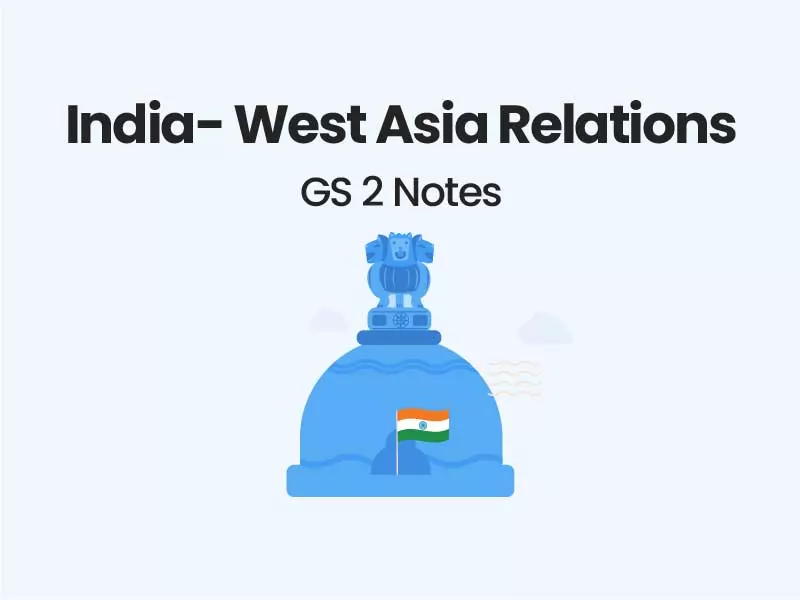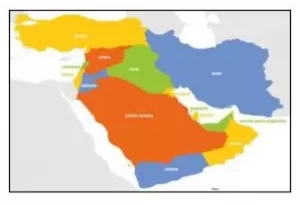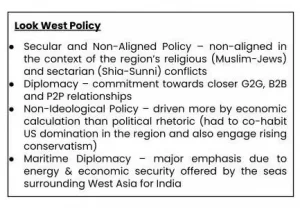Companion@360 → 7 Month programme to sharpen your writing skills → REGISTER NOW

India- West Asia Relations
West Asia is a part of India’s extended neighbourhood. India has enjoyed exceptionally close historic and civilizational ties with West Asia. Centuries old bilateral trade had benefited both sides greatly as it enhanced their knowledge and understanding of each other.
The Arabs acted as a conduit to the West taking Indian knowledge like numerals and traded Spices, foodstuffs jewellery, textiles and muslin and other goods flowed from India toward the Arab region, while pearls and dates were exported from the Gulf region.
India-West Asia Relations – Background
For decades, India was a passive player in West Asia – a beneficiary of good relationships with multiple actors.
During the Cold War years, India maintained close economic cooperation with both Saudi Arabia and Iran, the rival poles in regional geopolitics.
In the post-Soviet world, the bi-directional approach has been expanded to a tri-directional foreign policy to accommodate the three key pillars of West Asia – Saudi Arabia, Iran, and Israel.
India adopted Look West policy in 2005.
India has huge stakes involved in the region such as energy, trade, and safety of Indian community in the region.
Significance of West Asia
Energy security – 70% of India’s imported energy needs come from West Asia.
Gateway to Central Asia – West Asia is also gate way to land locked and energy rich central Asia.
Trade & Investment – The economic ties between India and the GCC countries are moving at a faster pace increasing the mutual interdependence
- UAE and Saudi Arabia are India’s third and fourth-largest trading partners respectively.
Economic Growth – India is the largest recipient of foreign remittances from West Asia, which plays a significant role in India’s growth.
Indian Diaspora – Six West Asian countries (UAE, Saudi Arabia, Kuwait, Oman, Qatar, and Bahrain) accounted for nearly 70% of all Indians who live abroad.
Culture & Religion – India hosts the 3rd largest Muslim population in the world, which views Saudi Arabia as its important pilgrimage.
Regional Connectivity – India has invested in Iran’s Chabahar port which is expected to a bridge of trade between India, Iran, and Central Asia along with Afghanistan.
Defence – India has a strong defence and security partnership with Israel which is useful for its security and military modernization drive.
Regional Stability – close cooperation is essential with west Asian nations to counter radicalization and rising terrorism in the region.
Maritime Diplomacy – West Asia is an integral part of India’s Indo-Pacific maritime domain.
- Naval cooperation has already been gaining momentum with Oman giving berthing rights to Indian naval vessels to fight piracy in the Gulf of Aden.
Drawbacks in India-West Asia Relations
- Political constraints – India’s narrow bureaucratic approach towards the Gulf was incapable of a political engagement with the region’s interests.
- For example, India viewed gulf countries through the prism of Pakistan.
- Low Investments – Despite India’s growing stature in the Gulf, it has not been able to attract substantial Arab investment.
- FDI from the GCC countries between 2000 and 2014 has remained stagnant at $3.2 billion.
- There is a wide gap between the investments that the Gulf is ready to offer and India’s ability to absorb needs.
- In 2015, Abu Dhabi committed to invest $75 billion in India. Still, India is a long distance away from facilitating that scale of investments.
- China factor – China has made rapid inroads in the Gulf by having acquired equity stakes in the region’s upstream oil and gas sector and having successfully penetrated Arab markets.
- China is continuously making in road to west Asia through OBOR initiative.
- India’s incapacity to manage its own periphery, South Asia, has made Gulf Arabs more inclined to seek China as a better security partner, rather than India.
- Pakistan factor – India’s “trust deficit” with Pakistan has incapacitated India from advancing its commercial interests in West Asia, including the bringing to fruition of the Iran-India-Pakistan (IPI) and Turkmenistan-Afghanistan-Pakistan-India (TAPI) gas pipeline projects.
- Arab slowdown & Nationalization – the decline of oil and gas prices, along with the rising cost of “war conditions” has led to the slowing of Arab Gulf economies, resulting in salary cuts, layoffs, contracting employment opportunities, and nationalization of workforces at the cost of Indian expatriate community.
Domestic Challenges within West Asia
- Political instability – The security situation in West Asia has been continuously deteriorating ever since the onset of the Arab Spring in December 2010. E.g., Syria, Yemen, and Iraq crises.
- The GCC-Iran rivalry, Shia-Sunni conflict, external intervention in the region, the fear of rise of religious radicalism etc. have further contributed to instability in West Asia.
- Involvement of global and regional powers – The involvement of extra-regional players such as the USA and Russia in the internal conflicts in West Asia has further aggravated the situation.
- Terrorism – Terrorism has emerged as the biggest security threat to the region. The rise of the Islamic State in Iraq and Syria (ISIS) is the most disturbing trend.
- Regional Conflicts – such as the Arab-Israel conflict, Israel-Palestine conflict and the Saudi-Iran rivalry create destabilizing effect in West Asia.
- US Sanctions on Iran: US withdrawal from Iran nuclear deal and has threatened to impose economic sanctions on Iran. This may weaken the dialogue mechanisms, embolden conservatives, and may threaten regional stability even more.
- India also has significant oil trade with Iran and stakes in connectivity through Chabahar port and other projects.
West Asia is one of the most volatile and sensitive regions in the world marked by historical injustices, intra-regional rivalries and competition for religious supremacy and loyalties. India treads its path very carefully and without prejudice. This has earned India the trust of almost all countries in the region and they look at India as an honest partner and friend.
Read Full GS Notes
Transformation of Gulf Region
- No Longer Exclusive Petro-States – The Gulf states have embarked on massive economic diversification and are investing in a variety of new projects including renewable energy, higher education, technological innovation, smart cities, and space commerce.
- Khaleeji Capitalism or Gulf Capitalism – Gulf has become the source of capital that has been built on the massive accumulation of oil revenues over the last few decades.
- For example, sovereign wealth funds in the Gulf dominate several regional sectors from banking and finance to infrastructure and logistics etc.
- Moving Towards Modernisation – Gulf countries, in the present times, seek to reduce the heavy hand of religion on social life, expand the rights of women, widen religious freedoms, promote tolerance, and develop a national identity that is not tied exclusively to religion.
- De-hyphenation of India-Pakistan – Today, the Gulf countries are eager to build strong and independent political ties with India, without getting affected by the India-Pakistan relations.
The Middle East has become more multipolar, with power diffused among a variety of regional and extra-regional actors. Within this mix, the rise of modern values and Khaleeji Capitalism in the gulf countries make the case for India to discard outdated perceptions of the Gulf and seize the new strategic possibilities with the region.
Opportunities for India
- In the wake of the Arab Spring and the mess in Egypt and Iraq, the Gulf states find India and China to be more reliable interlocutors than many western states.
- West Asia is looking to India and other Asian powers to step in and offer security guarantees to the region.
- Many GCC states have welcomed defence cooperation agreements with India.
- Leveraging Gulf-Israel Normalisation – UAE and Bahrain have normalised relations with Israel recently. This provides an opportunity for India to increase economic and technological engagement with Israel.
- Palestinian President Mahmoud Abbas called for a potential Indian role in the West Asian peace process.
- Geostrategic interests – stronger and deeper ties will enable India to reduce the influence of China in west Asia and in Arabian Sea.
India is in the good position of being trusted by all the major factions in the Middle East. India needs to continue the balancing act in West Asia that allows it to have good relations with Saudi Arabia, Iran, and Israel alike, the three poles of power at loggerheads with each other in the region. At the same time, maintaining distance from regional fractures and conflicts would allow India to pursue its economic and geo-strategic aims in the region.
Way Forward
Job Security for Expatriates – Due to economic instability caused by the pandemic, the Gulf countries are considering cutting back on foreign labour. India should ensure that the Indian expatriates will not be affected by this.
Focusing Beyond Oil – There is a need to focus on the new and long-term possibilities for economic cooperation with the Gulf countries, which is looking at a future beyond oil.
Medical tourism can be an important area where India can attract the UAE given India’s high-quality manpower in medical sector and improving medical infrastructure in the country.
Getting Along with Khaleeji Capitalism – With the rise of Khaleeji capitalism, the Gulf countries today deliver economic and security assistance to friendly states, build ports and infrastructure, acquire military bases and broker peace between warring parties and states. India needs to leverage this opportunity
Though energy has been the foundation of India and Gulf countries ties, there has been a remarkable shift in the relationship lately, and the recent focus on counterterrorism and security is reflective of maturing of our relationship and elevated role in this region.
However, the Covid19 pandemic has worsened economic outlook, exacerbated India’s problem of reverse migration and impacted Gulf sovereign wealth funds. In this climate, what India can do is focus on fast-tracking existing projects and re-engage with purpose in strategic sectors like healthcare, nuclear and space cooperation.
India is undergoing an economic transition, along with which its political, military, and cultural power is also likely to increase, elevating India to a 21st Century superpower. Meanwhile, UK has much to offer India in education, research, civil society, and the creative sector. The massive growth of India’s English-speaking middle classes offers a critical window of opportunity for the UK to become a partner of choice for trade, diplomacy, culture, and education before India’s next generation turns its attention elsewhere.
The profound ties of culture, history and language already give the UK a potentially strong foundation upon which it can further deepen its relationship with India. With a whole new set of circumstances, India and Britain should recognise that they both need each other to achieve their larger goals.


